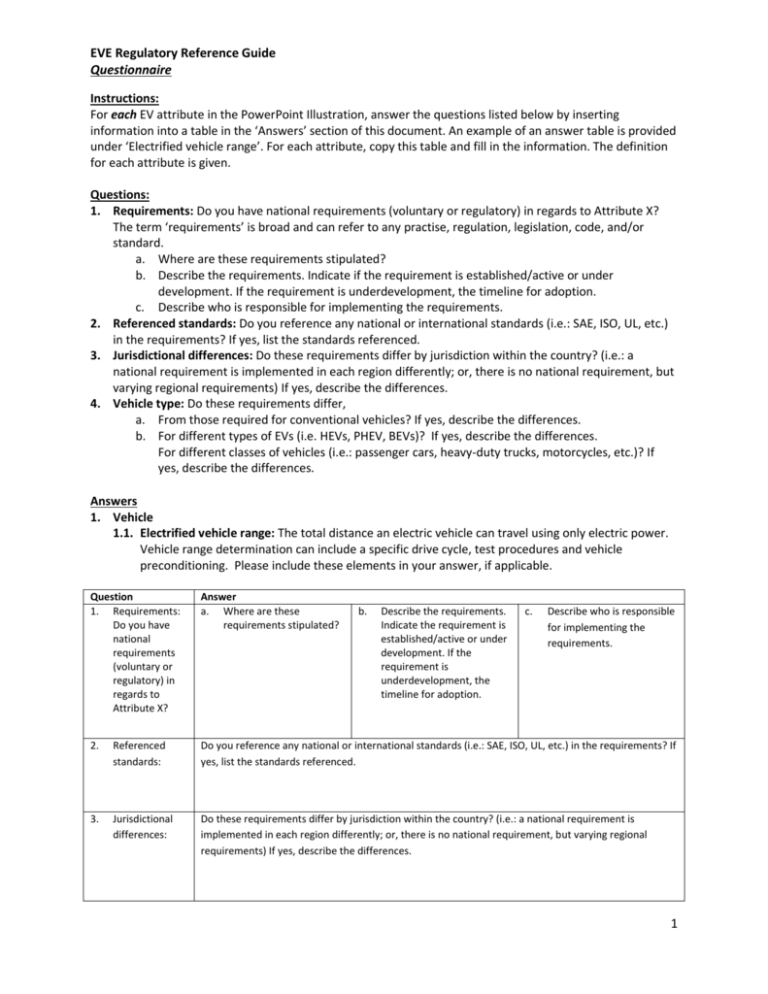EVE-03-04e
advertisement

EVE Regulatory Reference Guide Questionnaire Instructions: For each EV attribute in the PowerPoint Illustration, answer the questions listed below by inserting information into a table in the ‘Answers’ section of this document. An example of an answer table is provided under ‘Electrified vehicle range’. For each attribute, copy this table and fill in the information. The definition for each attribute is given. Questions: 1. Requirements: Do you have national requirements (voluntary or regulatory) in regards to Attribute X? The term ‘requirements’ is broad and can refer to any practise, regulation, legislation, code, and/or standard. a. Where are these requirements stipulated? b. Describe the requirements. Indicate if the requirement is established/active or under development. If the requirement is underdevelopment, the timeline for adoption. c. Describe who is responsible for implementing the requirements. 2. Referenced standards: Do you reference any national or international standards (i.e.: SAE, ISO, UL, etc.) in the requirements? If yes, list the standards referenced. 3. Jurisdictional differences: Do these requirements differ by jurisdiction within the country? (i.e.: a national requirement is implemented in each region differently; or, there is no national requirement, but varying regional requirements) If yes, describe the differences. 4. Vehicle type: Do these requirements differ, a. From those required for conventional vehicles? If yes, describe the differences. b. For different types of EVs (i.e. HEVs, PHEV, BEVs)? If yes, describe the differences. For different classes of vehicles (i.e.: passenger cars, heavy-duty trucks, motorcycles, etc.)? If yes, describe the differences. Answers 1. Vehicle 1.1. Electrified vehicle range: The total distance an electric vehicle can travel using only electric power. Vehicle range determination can include a specific drive cycle, test procedures and vehicle preconditioning. Please include these elements in your answer, if applicable. Question 1. Requirements: Do you have national requirements (voluntary or regulatory) in regards to Attribute X? Answer a. Where are these requirements stipulated? 2. Referenced standards: Do you reference any national or international standards (i.e.: SAE, ISO, UL, etc.) in the requirements? If yes, list the standards referenced. 3. Jurisdictional differences: Do these requirements differ by jurisdiction within the country? (i.e.: a national requirement is implemented in each region differently; or, there is no national requirement, but varying regional requirements) If yes, describe the differences. b. Describe the requirements. Indicate the requirement is established/active or under development. If the requirement is underdevelopment, the timeline for adoption. c. Describe who is responsible for implementing the requirements. 1 EVE Regulatory Reference Guide Questionnaire 4. Vehicle type: a. Do these requirements differ from those required for conventional vehicles? If yes, describe the differences. b. Do these requirements differ for different types of EVs (i.e. HEVs, PHEV, BEVs)? If yes, describe the differences. c. Do these requirements differ for different classes of vehicles (i.e.: passenger cars, heavy-duty trucks, motorcycles, etc.)? If yes, describe the differences. 1.2. Energy consumption/efficiency: Energy required to travel X km in standardized conditions. Energy consumption/efficiency determination can include a specific drive cycle, test procedures and vehicle preconditioning. Please include these elements in your answer, if applicable. 1.3. Vehicle driver-user information: Standardized symbols for system warnings, charge systems, etc. 1.4. Vehicle recycling and re-use (excluding the battery) 1.5. Vehicle labeling: Requirements for vehicle labelling, including the drive cycle and test procedure used to obtain information for the label. Labels may indicate, but are not limited to, fuel efficiency, emissions, range, total battery capacity (kWh), cost, etc. 2. Battery 2.1. Battery performance: Methods and conditions for testing and measuring battery power delivery capability, energy storage capacity, battery charge, etc. 2.2. Battery durability: Methods and conditions for determining average life cycle count, shock and vibration resistance, temperature, etc. 2.3. Battery recycling: Requirement for minimum battery material recycling. 2.4. Battery re-use (post-mobility) requirements 3. Infrastructure 3.1. On-board charging system: Specifications and requirements for on-board charging system, including voltage, current, port for AC and/or DC power, etc. 3.2. Off-board charging standard related to the vehicle: Specifications and requirements for off-board charging system, including port for DC power, battery communication interface/battery management system communication interface, etc. 3.3. Wireless charging: Vehicle-related specifications and requirements. 3.4. Vehicle as electricity supply: Vehicle-related specifications and requirements for transferring electricity from EVs to the grid. 4. Market deployment support 4.1. Regulatory incentives: Legal requirements that contain an incentive for deployment of electric vehicles. The term ‘legal requirements’ is broad and can refer to any regulation, legislation, code, and/or standard that is rooted in law. 5. Annex 5.1. Financial incentives: Financial support provided by the government to vehicle manufacturers, businesses, organizations, and/or consumers for the purchase of an electric vehicle. 5.2. Consumer awareness: Education and outreach activities supported by the government to increase awareness about electric vehicles. 5.3. Government purchasing: Requirements and/or financial incentives within government operations incentivizing the purchase and use of electric vehicles. 2









![1 maximum speed of 20 mph, ... [3].](http://s2.studylib.net/store/data/011902209_1-2999dd5b4e89845f3c3ee3a982412912-300x300.png)